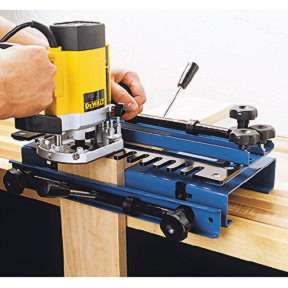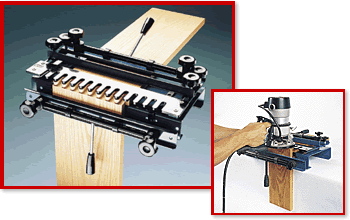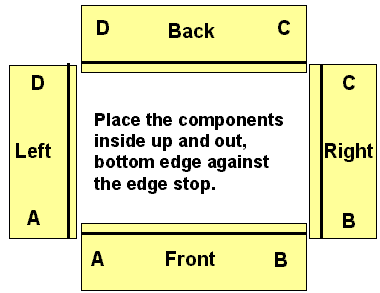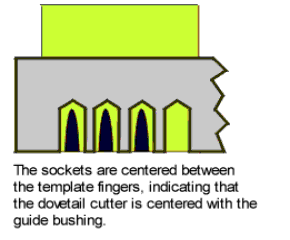|
Page Directory
Introduction
What I Like
What I Don't Like
The Bottom Line
Guide Bushings
Using the Jig
Suggestions
Alternatives
Site Directory
Home
Tool Reviews
Projects & Plans
Articles
Our Shop
FAQs
Sites I Like to Visit
Build a Kayak
E-Mail Us!
|
|
 I purchased the Woodstock / Grizzly Dovetail jig about two years ago. This jig is designed
primarily to cut half-blind (HB) dovetails. However, retailers sell optional templates to cut box
joints. I have used this jig to build quite a few drawers and it works fine. In retrospect, I
wished I had purchased the Porter Cable Model #4112 which goes for about $80.00 -$100.00 (we have since purchased the PC 4112, and replaced it with the PC 7116). At the time,I liked the cam, single lever clamps of the Woodstock jig and its general beefier feel. However,after using the jig, the cam single lever clamps are not so hot and I have found that though the frame is strong, arguably the most important part, the comb template, is a little too flexible. I purchased the Woodstock / Grizzly Dovetail jig about two years ago. This jig is designed
primarily to cut half-blind (HB) dovetails. However, retailers sell optional templates to cut box
joints. I have used this jig to build quite a few drawers and it works fine. In retrospect, I
wished I had purchased the Porter Cable Model #4112 which goes for about $80.00 -$100.00 (we have since purchased the PC 4112, and replaced it with the PC 7116). At the time,I liked the cam, single lever clamps of the Woodstock jig and its general beefier feel. However,after using the jig, the cam single lever clamps are not so hot and I have found that though the frame is strong, arguably the most important part, the comb template, is a little too flexible.

A friend of mine purchased the Harbor Freight, Central Machinery version of the Woodstock jig.
It is exactly the same jig. The only difference was the HF model came with a worthless manual. The
Woodstock manual is very clear and describes all of the necessary steps to cut HB dovetails.
- Assembly was easy. Basically all that is necessary is to screw in the handles and knobs.
- The basic sub-frame is well made and very strong.
- Setup for the first set of drawers took less than an hour. The manual was very clear. I was surprised
that the comb template did not control the depth of the drawer front sockets. Rather, the jig uses
a right-angle stop bar/fence to adjust the depth. Most HB Dovetail jigs adjust the comb template in and out to
adjust the socket depth. This is not a big thing, but it was unusual.
- Like all HB dovetail jigs, this jig only requires one bit--a 1/2 dovetail cutter.
- Very little tear-out. Unlike the Leigh, but like most HB Dovetail jigs, both the side and front are machined
at the same time. Thus the front provides a backer board that supports the side. I did get some
tearout on what turns out to be the inside of the drawer sides, but only when machining veneered plywood.
- The clamps and clamp bars hold everything down very tight.
- The first set of drawers came out perfect.
- Excellent manual.
- Woodstock and Grizzly offer a number of optional templates for larger/smaller dovetails and for
making box joints.
- Flimsy template. The template is some kind of plastic and it flexs and cracks. When you butt
the drawer side against the bottom of the template, you have to be careful not to flex it. I have
some cracking on mine as well. The template can also flex a bit when adjusting/lowering it in to
place. You just have to be more careful with it than the aluminum templates of the other jigs.
- I don't like the stop bar/fence idea. It works, but I would prefer to adjust the comb template
in and out which would save on some hardware and the somewhat awkward adjustment procedure. Plus, I
have more confidence in the bushing being the stop index rather than the router base.
- Lots of plastic. The plastic knobs and eccentric cams don't inspire confidence in longevity. I
must say that I have not cracked or broken them, but they don't seem long for this world.
- The rear of the jig has two sets of three knobs placed very close together. Makes it somewhat difficult
to adjust things. Frankly, after you have adjusted the jig, you can toss most of the knobs and
replace them with hex-head bolts.
- The length/depth of the tails seems a bit shallow. I might be wrong, but similar jigs seem to cut a
slightly longer tail. This is not a big thing, more of an observation. However, the advantage of the shallow
tail is that you can get by with 3/4" drawer fronts (rather than 13/16" - 7/8").
|
Cutting HB dovetails using this or other HB jigs is a piece of cake:
- Machine your sides and fronts to the desired thickness. All mating edges need to be square.
I plane the fronts to 3/4" and the sides to 1/2". I design the widths of the drawer sides so that
I end up with a 1/2 pin at the bottom and top.
- Mark the workpieces. I lay the four pieces on my workbench and mark them as shown in Figure 1.
- If the material is prone to chipping, I scribe a line at the base of each cut using my marking gauge.
- Place the drawer front under the top clamp, inside up.
- Place the side piece, inside out, under the front clamp and butt the front edge up against the
bottom of the comb template, against the side stop, and against the drawer front. Usually, I have to slide the drawer front
forward or back a bit so that both work pieces are touching.
- Cut the dovetails.
- If the fit is too tight, adjust your bit to make a slightly shallower cut. If the fit is too loose, adjust the bit to
make a deeper cut. The deeper the cut, the tighter the fit.
| Figure 1

|
- Check out my drawer making tutorial.
- Don't rotate the router as you're machining the joints. The router base and template guide bushings are not always perfectly centered with the router bit and may not be equi-distant with the outside circumference of the router base. Any slight imperfection here seems to multiply several times which results in poorly fitting joints, corners that don't match, etc. Consider purchasing a precision guide bushing from Leigh, Hartville Tool, or....Remember, the Woodstock jig uses the router base and its stop bar to control the socket depth.
- Use sharp bits to reduce tear-out and uneven bottoms.
- Test cuts are a necessity. Consequently, when you are milling your work pieces, always cut a few "spares" for testing.
- Your work pieces need to be square and flat.
- Use eye and ear protection. Unlike shaping operations which usually only take a few minutes, machining joints for cabinet drawers can take hours of continuous router use. Protect your eyes and ears!
- Wear a smock to facilitate casting off the tons of chips that are thrown back. Consider purchasing the Leigh RVA (Router Vacuum Attachment). It works with most routers and sucks the chips and dust almost directly from the cutter.
- Copy the manual and keep it near the jig.
- If you're going to use plywood for the drawer parts, use Baltic Birch, ApplePly, or another of the
finer plywoods. Your typical veneer hardwood plywoods tend to chip and tear.
- I use a rip blade to dado the slot for the drawer bottom. A trick I learned from the Frank Klausz
tape: After you have finished the last pass for the last drawer side/front, raise the blade and rip
the bottom of the back piece. Thus the width of the back piece will be equal to the distance from the
drawer side/front top edge to the top edge of the drawer bottom dado. Later, when assembling the
drawer, you can slide the bottom in from the back and nail it to the bottom of the back piece.
Works great!
- The March/April 1993 Issue of Fine Woodworking ran a great article by John Lively about making Drawers using
the $100-type Half-Blind jig. The best article I have found on the subject. It pretty much covers the subject
soup to nuts.
Works as advertised and it beats my Leigh for cutting HB Dovetails. However, unless you are on a
very stringent budget, buy the Porter Cable #4112 or one of its clones (Hart, RBI). The PC #4112
is a little easier to setup and its templates are aluminum which are stiffer than the Woodstock template.
 Guide bushings (also known as collars or a guide bush) are extremely versatile and indispensible for many router operations. However, I have learned the hard way that guide bushings can be a source of fit problems when used with dovetail jigs, especially combination jigs like the Leigh and the AKEDA. Guide bushings (also known as collars or a guide bush) are extremely versatile and indispensible for many router operations. However, I have learned the hard way that guide bushings can be a source of fit problems when used with dovetail jigs, especially combination jigs like the Leigh and the AKEDA.
I have found two common problems with guide bushings:
- They are often poorly machined. Their diameter and out-of-center tolerances vary greatly. I have guide bushings that are .030" out-of-center!. The best bet is to purchase precision guide bushings from Leigh, AKEDA (through Woodcraft), or whomever. Leigh offers precision 7/16" and 5/8" OD bushings, AKEDA offers a 7/16" precision bushing. The 7/16" OD bushing is the most widely used bushing with the Leigh and AKEDA dovetail jigs. The PC4112/PC7116 use the 5/8" OD bushing. Note that for through and half-blind dovetails, the guide diameter is not super critical on the Leigh, since fit is controlled by moving the pin template out/in (through dovetails) or by raising/lowering the bit (half-blind dovetails).
- Even if you have precise guide bushings, depending on your router, it may be difficult to center the router bit perfectly within the guide bushing. Perfeclty centering the router bit to a guide bushing is easier said than done. For instance, Porter-Cable routers mount their base to the router using flat head screws. As you tighten the screws, they center themselves in the base, drawing the base to "their center". Thus trying to center them is almost impossible. Some Bosch bases (1617 for instance) are mounted with pan-head screws, which do allow for some adjustment. However, you still may not be successful in perfectly centering the base, bushing, and bit (even with their centering cone).
 To determine whether your bit is centered in the guide bushing, simply lower the bit into the bushing, rotate the bit, and look to see whether the tips of the bit are centered within the bushing for an entire rotation. Since a dovetail bit is angled, you can lower it into the guide bushing until it barely touches--just make sure to rotate it backwards. Or, better yet, perform the following: To determine whether your bit is centered in the guide bushing, simply lower the bit into the bushing, rotate the bit, and look to see whether the tips of the bit are centered within the bushing for an entire rotation. Since a dovetail bit is angled, you can lower it into the guide bushing until it barely touches--just make sure to rotate it backwards. Or, better yet, perform the following:
- Mount the guide bushing and a straight bit in the router. The straight bit diameter must be less than the OD of the guide bushing.
- Setup your DT jig guide fingers to cut tails.
- Clamp a test board under the tail guides.
- Run the router through several guides.
- Visibly inspect the cut to determine that the cut is centered within the tail finger space. If it is centered, you're done.
- Otherwise, loosen the guide bush, rotate it 1/4 turn, and tighten it again.
- Repeat these steps until you get a satisfactory cut. You might want to mark the face of the guide bushing and router base to simplify this procedure next time around.
- If you cannot get the bit to center with the guide bush, try another guide bush. If you still have problems, you can try centering the base of the router/guide bush to the bit, but again, this is easier said than done.
- If you cannot correct the off-center problem, you might lessen the problem if you rotate the bushing so that the greatest deviation faces away from the jig (towards the operator). Then, make sure you keep the router facing the same direction as you rout the dovetails.
Don't discount making through dovetail joints by hand or the hybrid method employing both the bandsaw and hand. If you're not doing a ton of through dovetail joints, doing them by hand makes sense. If you're a novice at making through dovetail joints by hand, buy or rent the Dovetail a Drawer video by Frank Klausz. Actually, this video teaches alot more than just dovetails. I found his general woodworking techniques to be very enlightening.
Here is a run down of dovetail jigs you might consider:
- AKEDA DC-16 Through and Half-Blind Dovetail Jig
The AKEDA DC-16 from AKEDA Jigs Incorporated is the new guy on the block and certainly is a must-consider dovetail jig. Without any adjustments, the jig produced flawless, variably-spaced through dovetails for a box on my first try. I had the same experience with my first drawer. The jig comes through on its promises: no adjustments, excellent dust collection, virtually no setup, dovetail layout is easy and repeatable. It is quite simply a joy to use. Also, I like the geometry of the dovetails. They're more aesthetically pleasing than most machine-produced dovetails. Woodcraft handles the distribution of the AKEDA DC-16 for the U.S.
- Leigh D4 Through and Half-Blind Dovetail Jig
The Leigh dovetail jig Leigh Industries, Ltd. Is considered one of the best jigs on the market. I have had one for many years and like it for through dovetails. Leigh offers an extensive array of accessories that allow you to mill mortise and tenons, a variety of box joints, and decorative joints.
- Porter Cable 16" and 24" (5116 and 7116) Dovetail Jigs
The Porter Cable #5115 and #7116 jigs run $350 and $400, respectively. They are among the most robust jigs on the market.
Porter Cable offers a variety of optional templates to compete with the Leigh as being one of the most versatile dovetail jig available. Someday we'll get around to publishing a review on ours.
- Porter Cable 12" 4112 Half-Blind Dovetail Jig
The Porter Cable #4112 dovetail jig runs about $100 and
is for my money, the best HB dovetail jig around. Click here to read my PC4112 review.
- Keller Through Dovetail Jig
The Keller is considered by some as the easiest-to-use through Dovetail jig. I agree! Models run $150-$450. I purchased my Keller 1601 from Seven Corners Hardware for $189.00, which is considerably less than the show price ($209) or the suggested retail price ($249). Check out the Keller web site! It provides
some great info and a gallery of work from Keller users!
- Woodrat Dovetail/Joinery Jig
The Woodrat is perhaps the most unique dovetail (joinery) jig on the market, and thus appears to have the largest learning curve. I have not used the jig, but it gets high points for versatility and creative/artistic capacity. Setups appear to be more complex than typical jigs. Runs in the neighborhood of $500.
- RBI Wood Tools
RBI sells a PC 4112 look-alike for $100.
- Hartville Tools Model 12378
The 12378 is another PC4112 look-alike for $100. Hartville sells aftermarket cam-action clamps for the 12378 that also fit the PC 4112.
- Woodhaven Dovetail Jigs
Woodhaven sells a variety of dovetail jigs including their new top-of-the-line jig that can be used in the conventional mode or on top of a router table.
- Sears Craftsman Dovetail Jigs
Don't laugh, my father uses one of the cheaper models with excellent results. I recently gave him my old Woodstock Intl jig so he might retire the Craftsman, but don't count on it.
- Woodstock Intl Half-Blind Dovetail Jig W1099
This jig, also sold by Harbor Freight (Central Machine) and others, runs between $40 and $60. It works pretty well.
- Katie Jig
A relatively new jig that has received good reviews. It runs $250 plus. Marc Sommerfeld demos the Katie at the Woodworking shows. Impressive in that you can clamp a tail and pin board in the jig at one time (given you're cutting them on a router table). This ensures the alignment of the top/bottom edges and could be a real time saver if you had a two router setup like Marc Sommerfeld has at the shows. One drawback I saw in the demo is that the tails/pins top/bottom orientation is swapped on each end, unless you had two setups. If you get a chance to attend the WW Shows, look at the side of Marc Sommerfeld's drawers and you'll see what I mean. Functionally sound, but......
- Stots Dovetail Template Master
You use this template master to make dovetail and box joint jig templates. You can use it to make templates of virtually any size. It runs about $50 plus another $30 for the router bits if you don't have them. I want to try this tool, but I just have not had the time to fool around with it. Review coming soon.
- Incra and Jointech Router Fence Incremental/Positional Jigs
I would not consider the Incra and Jointech jigs for production work, but they work well if you are up to the setup. They work as advertised, but are time consuming to setup and use compared with dedicated dovetail jigs. For what
it's worth, I prefer the Jointech positioner over the Incra. The Jointech is more roubust, uses leadscrew technology instead of the incremental racks, templates are easier to use, provides built-in centering, and their fence construction and design is excellent.
- The $19.99 Half-Blind Dovetail Jig
The Popular Woodworking September 1999 issue ran an article on a $19.99 half-blind dovetail jig. Click here to view the article in PDF Format. The author (Troy Sexton) explains how to make a simple router template to machine the pins. The tails are cut
on the bandsaw. The price of "$19.99" includes $11 for a 23/32" diameter template guide and $8.95 for 1/2" 14 degree a dovetail bit. You probably already have these items. The simplified process:
- Rip a 5/16" thick template the same width as your drawer pieces.
- Use a dado to cut notches on one end of the template. One notch per tail.
- Clamp the template to the back side of the drawer front.
- With your router sitting on top of the template, run the router in and out of the notches.
- Use the cut pins to layout the tails.
- Cut the tails on your bandsaw.
Was this article helpful? Do you have any questions? E-Mail Us! We would love to hear from you!
|